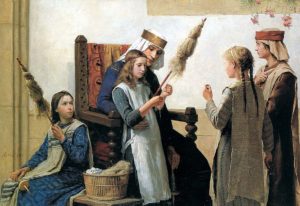Mid-Winter Musings
Cathy Koos
As I write this, calendar winter is just arriving in Northern California. We had a gully washer a few weeks ago, but the weather since has been anything but winter-like. I hope the holiday season treated you and yours well!
Distaff or Roc Day has passed and like spinsters and weavers from old, we are back to our looms and wheels.

As this issue arrives in your inbox, Ground Hog Day rapidly approaches. I grew up in Pennsylvania where this event is very popular with the PA Dutch community. In Punxatawney, PA whether or not local groundhog Phil emerges from his den and sees his shadow (or not), the day is used as a predictor for spring. Considering the big “cyclone bomb” storm last weekend, I would imagine Phil is snoring away, snug in his den.

The Pandemic. It’s still here. I read a lot and, like Alice, often find myself down some crazy rabbit holes. I read something obscure about Eyam, a tiny village in the Derbyshire Dales of England’s Peak District. This village was first occupied by ancient Britons, and then Romans as a significant lead mining region. But what brought this isolated village its fame was a flea ridden bundle of woolen cloth from London delivered to the town tailor in 1665, and with it the bubonic plague, courtesy of the fleas.
Soon the plague took a vicious hold with deaths everywhere, and the villagers turned to their local clergy for leadership. Measures included outdoor worship and quarantine of the entire village. Sound familiar?! Lockdown 17th century style.
Boundary stones were set in a no-man’s-land perimeter around the town. Merchants and friends would bring supplies to the boundary stones and collect vinegar-soaked payment in exchange. The original, sanitary, contactless shopping and Uber delivery!

While the distance between Eyam and London is a just a few hours today on the M1 motorway, back in 1665 travel time was days long. Although self-quarantine was a daunting solution, without vaccines or intensive care units, it was the only choice.
After 14 months, the plague ran its course. Numbers vary, but up to half of the village’s eight hundred residents died. All from a flea-infested bundle of cloth.
We have come a long way since plague times! At the click of a button or two, we can order textile supplies from all over the world and blueberries from the market around the corner. We can communicate with each other from the comfort of our homes by phone, FaceTime or Zoom. But don’t forget our local producers and craftspeople.
For next page click here